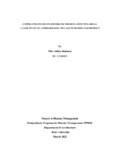Coping strategies in riverbank erosion affected areas: A case study of Andharmanik village in Manikganj district.

View/Open
Date
2022-03Publisher
Brac UniversityAuthor
Rahman, Md. AbdurMetadata
Show full item recordAbstract
Bangladesh is considered to be the biggest delta in the world. It is crisscrossed by the
Ganges, Brahmaputra, and the Meghna river system and their branches and distributaries. It
is also considered to be one of the most disaster-affected countries in the world. In
Bangladesh, there are few disasters that visit every year. Among them, flood and river
erosion is a very common disastrous event. Each year thousands of people lose their crops,
houses, livelihood, homestead land, cultivable land, and become homeless. Road,
embankments, schools, mosques hospitals, and other rural infrastructures are damaged and
eroded away due to river erosion.
The erosion affected people migrate to cities or nearest town and they live in the urban slum
areas. Some major effects due to the riverbank erosion are- displacement of people from one
place to another, the effect on public health, educational structure, people's occupation and
livelihood, unemployment rate increases, affect in agricultural production, transportation,
etc. The major causes of riverbank erosion are flooding, deforestation, heavy rainfall,
unplanned settlement, land use, the strong current of the river, over clearing of the
catchment, gravel extraction, and poor river management.
This study tried to explore the local people coping strategies with riverbank erosion of
Andhermanik village in Harirumpur Upazila of Manikganj district. Primary and secondary
data were used in the study. The data were collected by questionnaire survey, key informant
interview, focus group discussions, and field observation. The results of the study showed
that people tried to adapt with the adverse situation by their own techniques. People have
experienced erosion more than two three times. The practiced coping strategies were
composed into physical, economic, and social strategies. Physical strategies include
evacuation, relocation, and migration. They also adopted housing-related coping strategies
like selling, dismantling, shifting to new areas.
Economic coping strategies include changing occupation, borough or loan money, opening
business, etc. Household’s ability to adapt with river erosion depends on people’s
socioeconomic and environmental conditions, such as education, income, and occupation.
Though river erosion causes the loss of lives and properties, people’s indigenous coping
techniques could significantly reduce their vulnerability without outside assistance.
Effective early warning systems integrate local coping practices with modern technology
and sustainably improve socioeconomic conditions are necessary to reduce the losses from
riverbank erosion.
